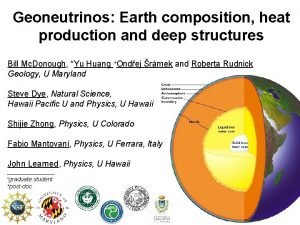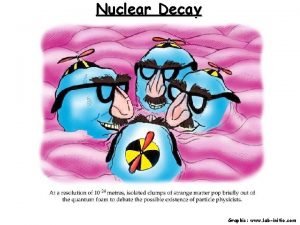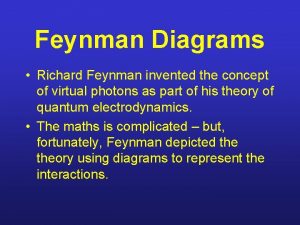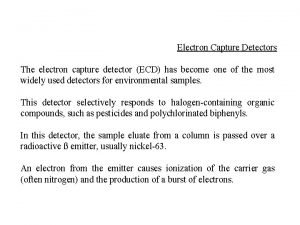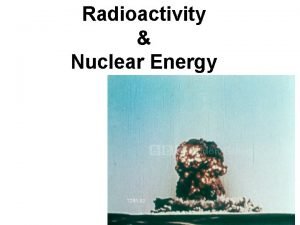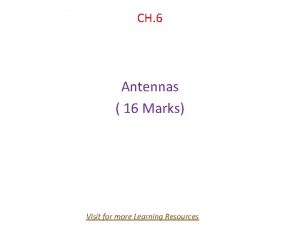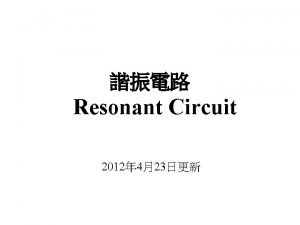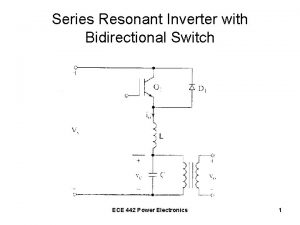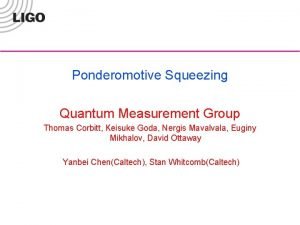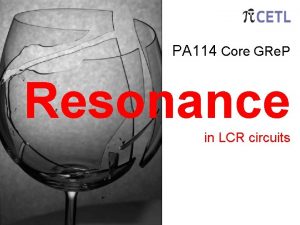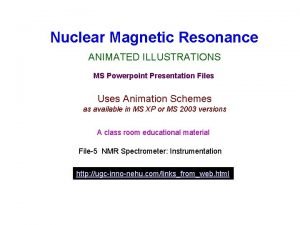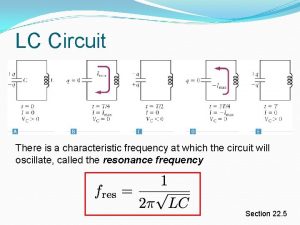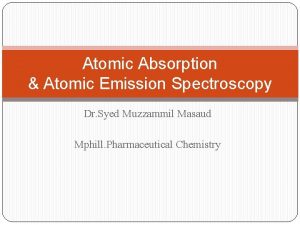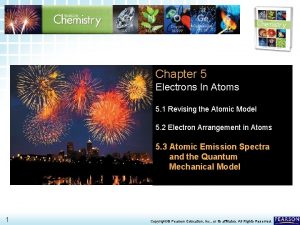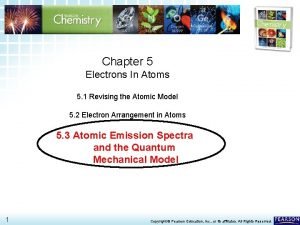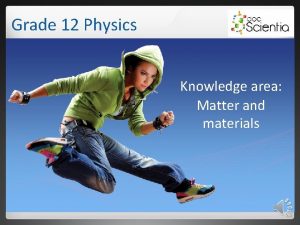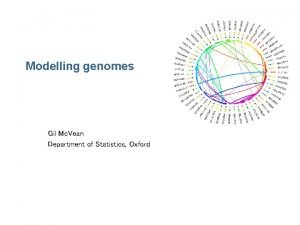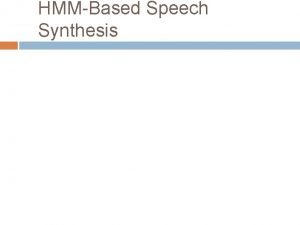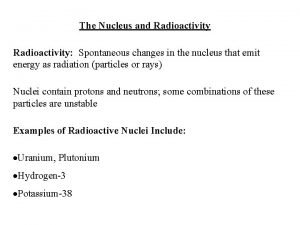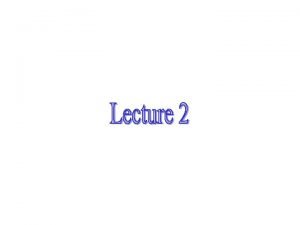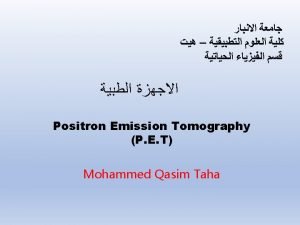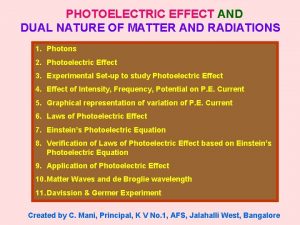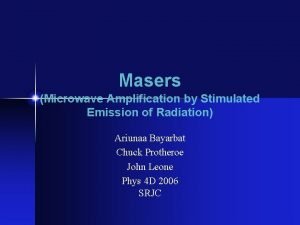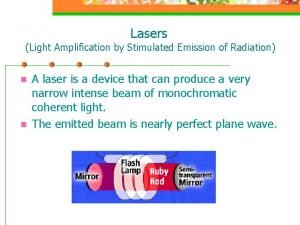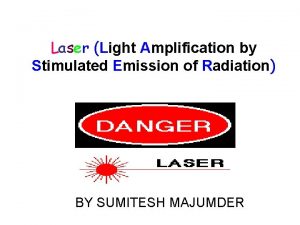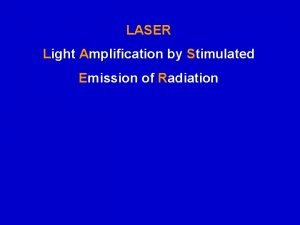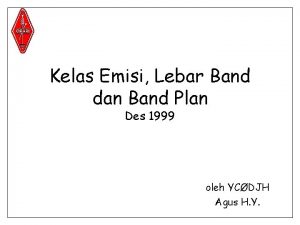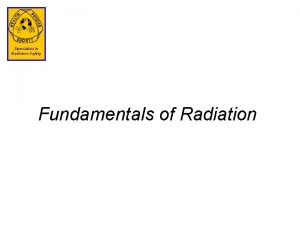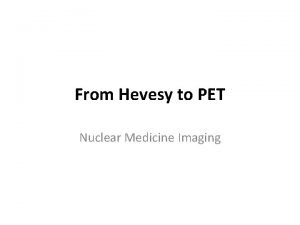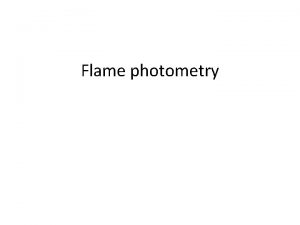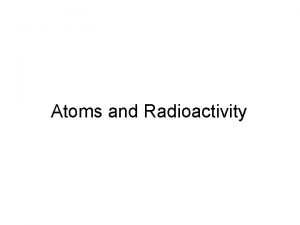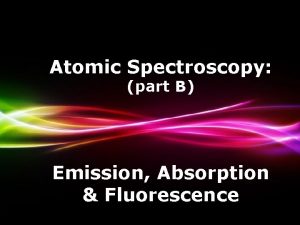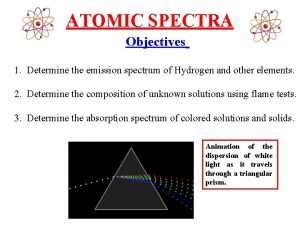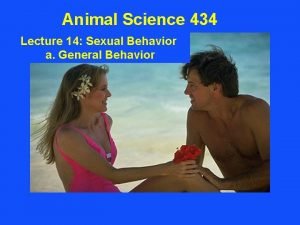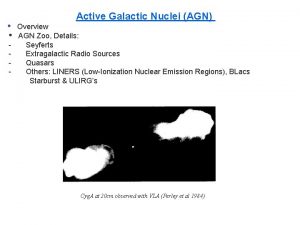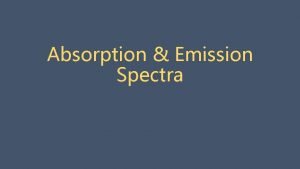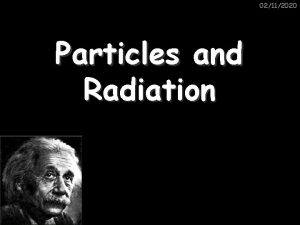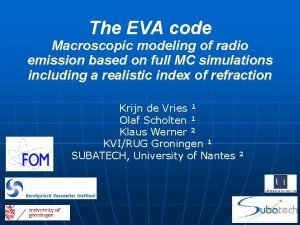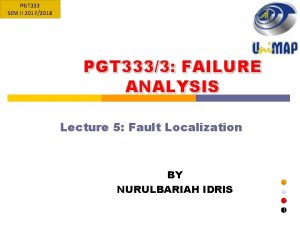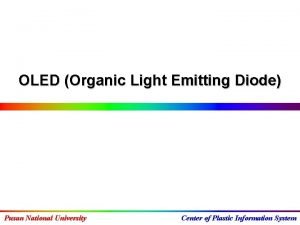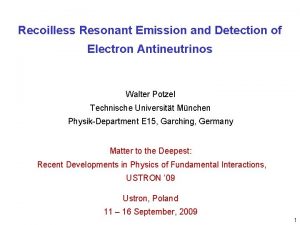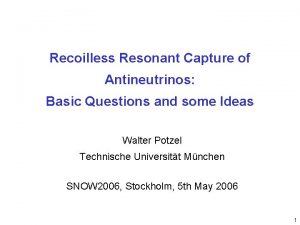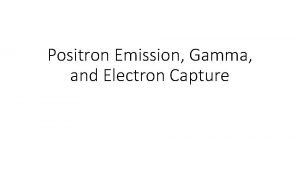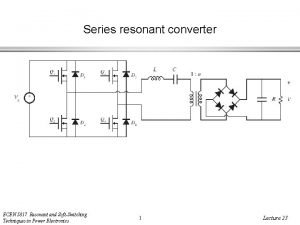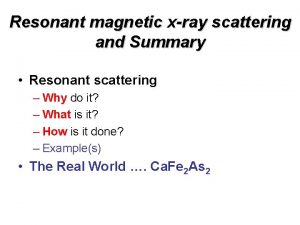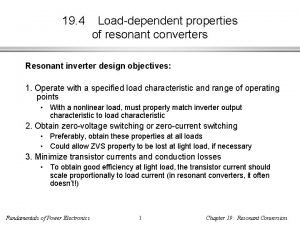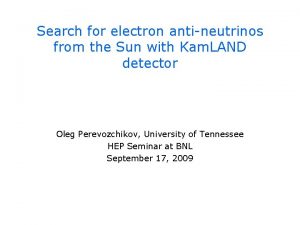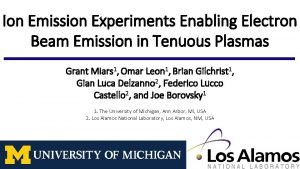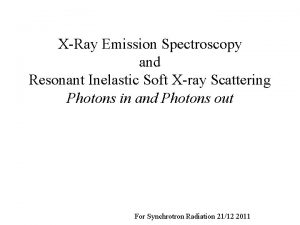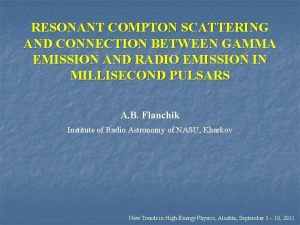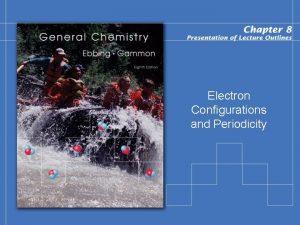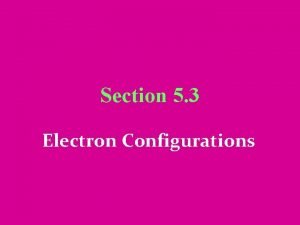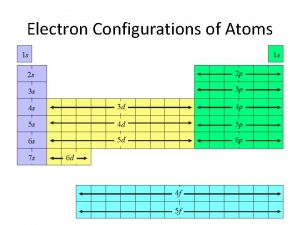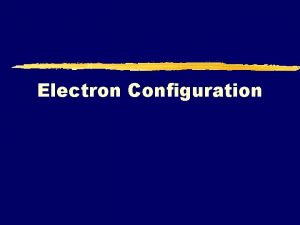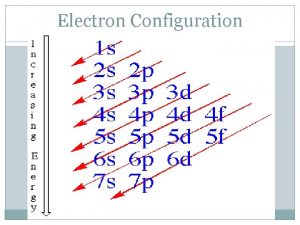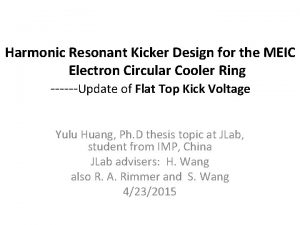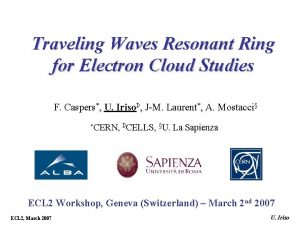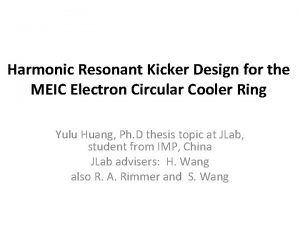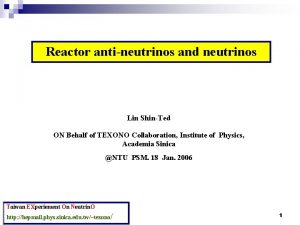Recoilless Resonant Emission and Capture of Electron Antineutrinos










































- Slides: 42

Recoilless Resonant Emission and Capture of Electron Antineutrinos: Mössbauer Anti-neutrinos Walter Potzel Technische Universität München Physik-Department E 15 LAUNCH: Particle and Astroparticle Physics, Max-Planck-Institut für Kernphysik, Heidelberg 23 March, 2007 1

Papers Earlier papers: W. M. Visscher, Phys. Rev. 116, 1581 (1959) W. P. Kells and J. P. Schiffer, Phys. Rev. C 28, 2162 (1983) Recent papers: R. S. Raghavan, hep-ph/0511191 and follow-up paper hep-ph/0601079 revised v 3, 13 Sep 2006 W. Potzel, Phys. Scrip. T 127, 85 (2006); S. M. Bilenky, F. von Feilitzsch, and W. Potzel, hep-ph/0611285, accepted for publ. in J. Phys. G 2

Outline I) Bound-state b-decay: resonant character II) Promising example: 3 H – 3 He system III) Recoilless emission and absorption: Mössbauer Anti-neutrinos 1) Recoilfree fraction 2) Linewidth 3) Relativistic effects: Second-order Doppler shift a) temperature b) zero-point motion IV) Consequences for real experiments V) Interesting experiments VI) Conclusions 3

I) b-decay I) Bound-state b-decay J. N. Bahcall, Phys. Rev. 124, 495 (1961) mono-energetic Bound-state atomic orbit. Not a capture of e- initially created in a continuum state (less probable). Example: 2 -body process, energy: has a fixed where end-point energy Atomic orbit in 3 He binding energy recoils 4

I) b-decay Reverse process (absorption): target for in atomic orbit Example: energy required for in atomic orbit of 3 He : recoils Bound-state b-decay has a resonant character which is (partially) destroyed by the recoil in source and target. 5

I) b-decay 3) Resonance cross section L. A. Mikaélyan, et al. : Sov. J. Nucl. Phys. 6, 254 (1968) for low Z, hydrogen-like ψ m: electron mass ψ2: probability density of e in A(Z) : resonant spectral density, i. e. , number of energy interval of 1 Me. V around value: in an reduced half-life of decay : super-allowed transition 6

II) Example: 3 H-3 He system 18. 60 ke. V 1132 sec 6. 9 x 10 -3 (80% ground state, 20% excited states) 3 H (source) and 3 He (target): gases at T=300 K →thermal motion, Doppler energy profile recoil energy: → resonant spectral density ρ≈106/0. 16≈6 x 106 2 ER≈0. 12 e. V; 2Δ≈0. 16 e. V →reduced overlap Resonance cross section: σ ≈ 1 x 10 -42 cm 2 To observe bound-state b-decay: 100 -MCi sources (3 H) and kg-targets (3 He) would be necessary 7

III) Recoilless antineutrino emission and absorption: Mössbauer neutrinos 1) Recoilfree fraction recoil energy: Stop thermal motion! Make ER negligibly small! 3 H as well as 3 He in metallic lattices: freeze their motion →no Doppler broadening. M→Mlattice>>M Leave lattice unchanged, leave phonons unchanged. zero-point energy Energy of lattice with N particles: 3 N normal modes with number of oscillators with frequency ω between ω and ω + dω 8

III) Recoilless antineutrino … Recoilfree fraction f: Debye model: f depends on: transition energy E mass M of the atom Debye temperature Θ T 0: Example: 3 H – 3 He typically: Emission and absorption: for Θ≈800 K for T 0 9

III) Recoilless antineutrino … 2) Linewidth t : lifetime minimal width (natural width): 3 H: t = 17. 81 y (extremely narrow) Two types of line broadening: a) homogeneous broadening b) inhomogeneous broadening due to fluctuations, e. g. of magnetic fields due to stationary effects, e. g. impurities, lattice defects How big are these broadening effects? 10

III) Recoilless antineutrino … a) homogeneous broadening Measurements: 3 H (Pd), 3 H (Ti-H), Nb. H Typical relaxation times: T 2~2 ms, 79µs DE ~ 8. 6 x 10 -12 e. V = GH ~ 7 x 1012 G 10 -12 e. V Transition energy 18. 6 ke. V Magnetic interactions: a) with atoms (nuclei) of metallic lattice b) 3 H – 3 H magnetic dipolar spin-spin interaction 3 H, 3 He Relaxation between the sublevels affects the lineshape and the total linewidth. The linewidth is determined by the relaxation rate. 11

III) Recoilless antineutrino … b) inhomogeneous broadening Many individual resonances displaced from the nonperturbed resonance energy E 0 In the best single crystals: (1 +a)G ~10 -13 e. V corresp. to 1011 G or larger Both types of broadening reduce the resonant reaction intensity 12

III) Recoilless antineutrino … 3) Relativistic effects Second-order Doppler shift due to mean-square atomic velocity <V 2> moving system Time-dilatation effect: stationary system Frequencies: Second-order Doppler shift: Reduction of frequency (energy) 13

III) Recoilless antineutrino … Within the Debye model: where Zero-point energy If degree → Low temperatures: If However, zero-point energy remains! degree → Energy levels (also the groundstate) depend on the surrounding atoms. 14

III) Recoilless antineutrino … What does this mean for the effective values s and t ? Source 3 H Target 3 He Lot of 3 H SOD 3 H 0 3 H 3 H 3 He The differences of these SOD values in source and target have to be the same. In a practical experiment this means: The Debye temperature for 3 H has to be the same in source and target. The same holds for 3 He. The Debye temperatures of 3 H and 3 He in the metal matrix do not have to be equal. 15

IV) Consequences … A) Preparation of source and target Source: 3 H chemically loaded into metals to form hydrides (tritides), e. g. , Nb: in tetrahedral interstitial sites (IS). Target: 3 He accumulates with time due to the tritium trick: Nb 3 Hx time=200 d Nb 3 Hx-y 3 Hey remove Nb 3 Hey Remove 3 H by isotopic exchange 3 H D 16

IV) Consequences … 3 He generated in Nb: c 1: concentration in interstitial sites for different temperatures and times. The He in the T-free absorber below 200 K is almost all interstitial. R. S. Raghavan: hep-ph/0601079 revised v 3; calculations: Sandia Natl. Lab. , USA 17

IV) Consequences … How much metal for source and target? Source: 1 k. Ci of 3 H (~100 mg 3 H): ~3 g of Nb 3 H for NMR studies: 0. 5 k. Ci 3 H in 2. 4 g Pd. H 0. 6 Target: 100 mg of 3 He implies ~100 g of Nb 3 H aged for 200 d 18

IV) Consequences … B) Event rates for 3 H – 3 He recoilless resonant capture of antineutrinos Antineutrino capture per day Rb(Dt=65 d) per day 100 mg ~40 x 103 ~40 1 g ~103 ~10 Base line 3 H 3 He 5 cm 1 k. Ci 10 m 1 MCi Rb(Dt)/day: Reverse b-activity rate after growth period Dt=65 d=0. 01 t 19

IV) Consequences … C) Requirements for successful experiment: 1) Recoilfree fraction: How are 3 H and 3 He bound in the metallic matrix? Difficult problem, needs inelastic neutron scattering experiments to determine the recoilfree fraction of 3 H and 3 He. Use low temperatures (liquid He) 20

IV) Consequences … 2) Source and target should be as similar as possible: Use low temperatures (liquid He) However: Source contains 3 H, whereas target contains mainly 3 He. Interaction (chemical bonds) of 3 H and 3 He with the metal atoms may be different because of different neighborhood 21

IV) Consequences … 3) Linewidth Two types of line broadening: a) homogeneous broadening b) inhomogeneous broadening due to fluctuations, e. g. of magnetic fields due to stationary effects, e. g. impurities, lattice defects Mössbauer Anti-neutrinos: Energy width: Cross section: 22

V) Interesting experiments 1) Quantum Mechanics: Do Mössbauer neutrinos oscillate? If yes, neutrino-oscillation experiments with ultra-short base lines possible 2) Determination of mass hierarchy and oscillation parameters Dm 232 and Dm 212: 0. 6% and sin 22 q 13: 0. 002 3) Search for sterile neutrinos 4) Gravitational redshift experiments (Earth). 23

V) Interesting experiments 1) Do Mössbauer neutrinos oscillate? Different approaches to neutrino oscillations CC weak process, U: unitary PMNS matrix Pontecorvo, Maki, Nakagawa, Sakata Transition probability: For only two flavors: Amplitude: Oscillation length: Oscillatory term: [m] 24

V) Interesting experiments Question: What will be the state of the neutrino after some time (at some distance L)? A) Evolution in time Schrödinger equation for evolution of any quantum system: No matter what the neutrino momenta are ! If Ek=Ei, there will be no neutrino oscillations: The neutrino state is stationary If Ek are different, neutrino state is non-stationary. →time-energy uncertainty relation holds: Dt is the time interval during which the state of the system is significantly changed If Ek≠Ei, the uncertainty relation takes the form: 25

V) Interesting experiments B) Evolution in time and space Mixed neutrino state at space-time point and with a) oscillatory phase b) neutrinos: different masses have the same energy neutrino state is stationary 26

V) Interesting experiments Mössbauer neutrinos: Energy width: a) observed with atmospheric neutrinos Mössbauer neutrinos take a long time to change significantly Time-energy uncertainty: Extremely long “oscillation “ length Determination of Θ 13: E=18. 6 ke. V instead of 3 Me. V. Chooz experiment: b) Oscillation base line: L 0/2~9. 3 m observed with solar neutrinos Amplitude: Oscillation base line: L 0/2~300 m Oscillation length: [m] 27

V) Interesting experiments Mössbauer neutrinos: Energy width: No (MSW) matter effect Hamiltonian in matter: Vacuum W exchange Z exchange Ne(n) = number of electrons (neutrons) per unit volume If all mass states have the same energy, all flavor states have the same energy E. and No coherent superposition No matter effect 28

V) Interesting experiments 2) If Mössbauer neutrinos do oscillate: Ultra-short base lines for neutrino-oscillation experiments Oscillatory term: Oscillation length: [m] A) Determination of Θ 13: E=18. 6 ke. V instead of 3 Me. V. Base line L of 9. 3 m instead of 1500 m 29

V) Interesting experiments B) Mass hierarchy and oscillation parameters H. Nunokawa et al. , hep-ph/0503283 m 2 ne normal hierarchy Ue 3 2 nt n 3 nm Dm 2 sol Dm 2 atm n 2 n 1 0 ? Dm 2 sol n 2 n 1 To determine mass hierarchy: Measure Dm 2 in reactor-neutrino and muon-neutrino (accelerator longbaseline) disappearance channels to better than a fraction of 1% Dm 2 atm H. Minakata et al. , hep-ph/0602046 inverted hierarchy n 3 ? For sin 22 q 13=0. 05 and 10 different detector locations one can reach uncertainties: in Dm 231 and Dm 212: 0. 6%, in sin 22 q 13: 0. 002 30

V) Interesting experiments 3) Search for conversion of LSND experiment: and sin 22θ~0. 1 to 0. 001 Possibility: V. Kopeikin et al. : hep-ph/0310246 Test: Disappearance experiment with 18. 6 ke. V antineutrinos Oscillation length L 0 ~5 cm! Ultra-short base line, difficult to reach otherwise 31

V) Interesting experiments 4) Gravitational redshift experiments (Earth) Gravitational redshift: Experimental linewidth: where is height corresponding to 1 experimental linewidth Can such an experiment be used to determine the neutrino mass? No! R. W. Kadel: hep-ph/0603211 has been withdrawn (wrong approximation). 32

VI) Conclusions 1) Recoilless resonant emission and absorption of antineutrinos: 3 H – 3 He system is the prime candidate. 2) Experiment is very difficult: a) Recoilfree fraction might be smaller than expected b) Temperature difference between source and target (temperature shift) c) Different Debye temperatures in source and in target (chemical shift) d) Homogeneous and inhomogeneous broadening of linewidth e) Removal of 3 H from the metal matrix 3) If successful, very interesting experiments become possible: a) Do Mössbauer neutrinos oscillate? b) Mass hierarchy and accurate determination of oscillation parameters c) Search for sterile neutrinos (LSND experiment) d) Gravitational redshift experiments (Earth). W. Potzel, Phys. Scrip. T 127, 85 (2006); S. M. Bilenky et al. , hep-ph/0611285 33

Extra slides 34

I) b-decay 1) Usual β-decay neutron transforms into a proton occupy states in continuum 3 -body process: Maximum show (broad) energy spectra energy: where is the end-point energy 35

Phonon density of states Zn metal 36

III) Recoilless antineutrino … G/GH H B. Balko, I. W. Kay, J. Nicoll, J. D. Silk, and G. Herling, Hyperfine Interactions 107, 283 (1997). 37

Candidates for recoilless neutrino absorption Recoilless fraction Line broadening W. P. Kells and J. P. Schiffer, Phys. Rev. C 28, 2162 (1983) 38

IV) Consequences … 6 TIS 3 OIS EST: self-trapping energy ZPE: zero-point energy Little difference between Deuterium and Tritium theoretical experimental activation energies 39

V) Interesting experiments 5) Real-time, 3 H-specific signal of resonance a) sudden change of the magnetic moment from -2. 1 nm (3 He) +2. 79 nm (3 H) transient (~0. 1 ms) magnetic field which couples to electron moment of 3 H via hyperfine interaction Read-out by SQUID b) new electrons appear in the Nb bands when 3 H is formed. These electrons cause additional specific heat that grows linearly with 3 H concentration. detectable by ultra-sensitive (micro)-calorimeters ? 40

Red(blue)shift 67 Zn. O-Mössbauer exp. gravitational redshift difference in height: 1 m in gravitational field of Earth gravitational blueshift accuracy: (DE/E) ≤ 1 x 10 -18 W. Potzel et al. , Hyp. Interact. 72, 197 (1992) 41

Gravitational Redshift Experiment 42
 Antineutrinos
Antineutrinos Electron capture symbol
Electron capture symbol Feynman diagram electron capture
Feynman diagram electron capture Electron capture detector
Electron capture detector Electron capture example
Electron capture example Current and voltage distribution in antenna
Current and voltage distribution in antenna Rlc q factor
Rlc q factor Ece 442
Ece 442 Resonant frequency
Resonant frequency Kyle corbitt
Kyle corbitt Resonant frequency formula
Resonant frequency formula Resonant inductive coupling ppt
Resonant inductive coupling ppt Resonant frequency formula
Resonant frequency formula Difference between absorption and emission spectrum
Difference between absorption and emission spectrum Atomic emission spectra and the quantum mechanical model
Atomic emission spectra and the quantum mechanical model Atomic emission spectra and the quantum mechanical model
Atomic emission spectra and the quantum mechanical model Emission and absorption spectra grade 12
Emission and absorption spectra grade 12 Transition and emission probability
Transition and emission probability Transition and emission probability
Transition and emission probability Positron emission equation
Positron emission equation Example of isotones
Example of isotones Positron emission
Positron emission Einstein equation for photoelectric emission is
Einstein equation for photoelectric emission is Maser
Maser Metastable state in laser
Metastable state in laser Stimulated emission
Stimulated emission Stimulated emission
Stimulated emission Class of emission
Class of emission Bread toasting: gas formation color change light emission
Bread toasting: gas formation color change light emission Partial periodic table
Partial periodic table George charles de hevesy
George charles de hevesy Advantage of flame photometer
Advantage of flame photometer Nuclear notation
Nuclear notation Atomic absorption spectrophotometer ppt
Atomic absorption spectrophotometer ppt Hydrogen atomic emission spectrum
Hydrogen atomic emission spectrum Atomic emission spectroscopy principle
Atomic emission spectroscopy principle Emission vs ejaculation
Emission vs ejaculation Miller zoo emission
Miller zoo emission Emission line spectrum
Emission line spectrum Neutrino lepton number
Neutrino lepton number Is code 800
Is code 800 Photo emission microscopy failure analysis
Photo emission microscopy failure analysis Plastic oled
Plastic oled
